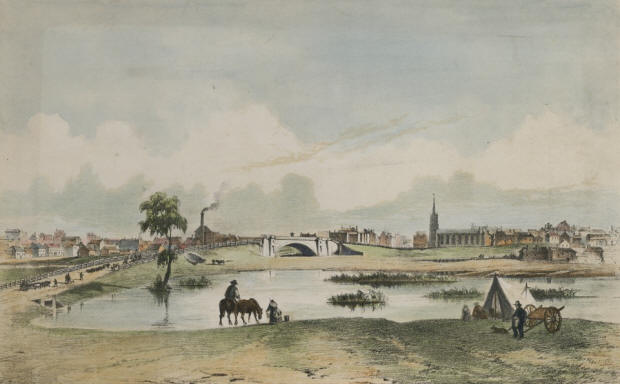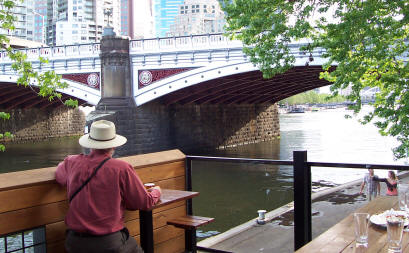Princes Bridge
This article was first published in the
White Hat Melbourne
Newsletter No.173 on 19 May 2006.
In that same newsletter you will
find some quiz
questions related to Princes Bridge.
When the first European settlers arrived in Melbourne in 1835 there was
no permanent crossing point of the Yarra River. Over time various punt and
ferry operators set up business but there was still no bridge. In those
times there was no point in waiting for the government in Sydney to provide
a bridge and most of Melbourne�s early infrastructure was provided by
private enterprise. On 22nd April 1840 a private company was set up with the
intention of constructing a bridge across the Yarra.
In our own time, we have become familiar with activist groups in country
towns who agitate for a bypass to be built around their town and then become
surprised that after it is built no-one seems to visit there and spend money
anymore and much of the employment dries up. Things were different in the
1840s. The traders in Elizabeth Street vied with those in Swanston Street to
have the through traffic that would be generated by a bridge.
Lieutenant-Governor La Trobe favoured an Elizabeth Street crossing, but
despite such official pressure the private company favoured the construction
conditions at Swanston Street and it was there in 1840 that they opened
their wooden toll bridge. Until that time William Street had been the de
facto main street of Melbourne since it led down to the docks, Coles Wharf
and the Western Market. With the construction of the bridge, Swanston Street
quickly became regarded as the main street and remained so until recent time
when the city authorities decided it would be a good thing if the
major carriageway should be closed to most traffic but not open up to
pedestrians.
By 1850, the government had caught up and built a fine single span
structure of brick and stone, opened it on 15 November, called it Princes
Bridge, and made it available to the public for free. Little did they know
that within a year, gold would be discovered in country Victoria, there
would be a population explosion, Melbourne would become recognised as �Marvellous
Melbourne� and the narrow carriageway on this fine bridge would become
inadequate for such a bustling city.

Come 1888 and our second International Exhibition, Melbourne had designed
and built the third bridge on the site and the one that we know today. By
that time the Yarra River had been heavily modified both upstream and
downstream and the major floods of the early years were becoming less
common. In the best Melbourne tradition, the bridge is built on solid
bluestone bulwarks � none of your flimsy Sydney sandstone here � with plenty
of cast iron. Solid yet elegant, befitting the style of the city which had
forced itself onto the international map.
When ex-pat Melburnians in London become homesick they make their way
down to
Blackfriars Bridge and through the mist and the rain pretend that they
are gazing at the structure that helped define the centre of gravity of
Melbourne.
This article was first published under the heading
Melbourne's Hidden Gems in the
White Hat Melbourne
Newsletter No.173 on 19 May 2006
If you make your way across Fed
Square towards Princes
Bridge you will find a set of bluestone steps leading down to river
level. At the base of the stairs is a series of vault-like structures cut
into the bank that have served many purposes over the years � few of which
would be approved of by the polite society crossing the bridge above. In
recent months, this area has been turned into a caf� and wine bar and I
sometimes like to sit there at the end of the day and watch the decades
slowly flowing past. �Would you like some water sir?� asks the
waiter. I remember that Garryowen,
writing at the time of the wooden bridge tells us �Originally the city
was solely dependent on the Yarra water, which was frequently unfit for man
or beast (but) the people of Melbourne had to swallow it, though often
rectified with large dashes of execrable rum or brandy.� �No thank you�
I tell the waiter � �I�ll have a scotch with no water�.
 |
From this position at the water�s edge it is possible to see little
huddles of tourists crossing the bridge and pausing to examine the painted
crests on the cast iron lamp posts. That is what their guide book instructed
them to do. At water level, indiscernible shapes float past just below the
water�s surface and I am reminded of Fergus
Humes� description of the place around the time of opening of the new
bridge. �Rats are scampering along among the wet stones, and then a
vagrant dog poking about amid some garbage howls dismally. What is that
black speck on the crimson waters? The trunk of a tree perhaps; no it is a
body . . . floating down with the current. People are passing to and fro on
the bridge, the clock strikes in the town hall, and the dead body drifts
slowly down the red stream far into the shadows of the coming night � under
the bridge over which the crowd is hurrying, bent on pleasure and business.�
Another group of tourists pauses to examine the painted crests. At water
level I am reminded that a century ago that this was the time of evening
that the other rats would gather - the group of street kids who called
themselves the Bourke Street Rats. They could make their way into the centre
of the city, rumble some drunks, then meet up back here next to the bridge.
The place where I am sitting has probably been used a number of times to
divvy up the takings with probably more than the fair share going to the
gang leader � a young thug called Squizzy. At around the same time, Clarice
Beckett gave us probably one of the best paintings of the bridge as seen
from the same position on the other side of the river. The tourists move on
across the surface of the city to their next approved stop.
With the fading light it is time to venture underneath the bridge. The
city lights reflect strange fractal patterns from the river onto the
bridge�s underbelly while the regular rumble of the trams overhead coax the
rivets into a song they have sung for over a century. And sometimes � just
sometimes � at this time you may see shadows and catch snippets of
conversation between the hyperactive 6 year old son of the bridge designer
who wants to know how everything works and the young engineer who has been
employed to work on the bridge while struggling to support his mother and
put himself through university at the same time. The young engineer
patiently explains how the interlocking patterns come together to form a
larger, stronger structure and is immediately bombarded with five more
questions. As I head off along the river I hear
John Monash quietly begin
his next explanation to the young
Percy Grainger.
A bridge can take you more places than just the other side of the river.

|
|
Copyright © 1995 - 2026
White Hat.
|
Other articles in the series Seven Monuments of Melbourne: